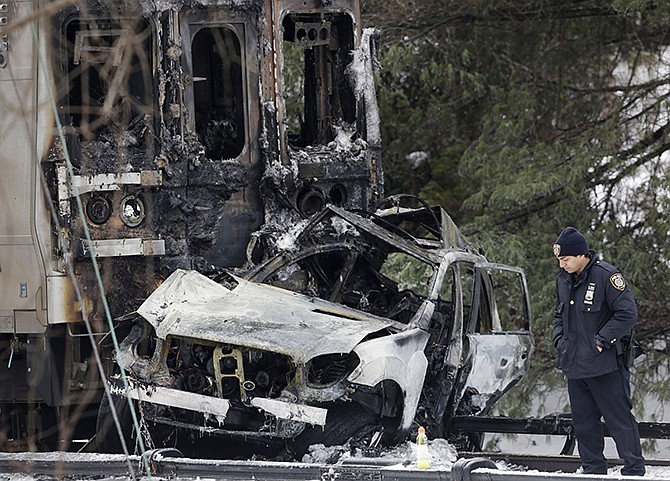VALHALLA, N.Y. (AP) - The baffling behavior of a woman whose SUV stopped between the crossing gates on a railroad track came under scrutiny Wednesday as investigators sought clues to a fiery commuter train crash that killed six people.
National Transportation Safety Board officials were looking at the Metro-North train's black-box-style recorders, seeking to learn its speed, whether brakes were applied and whether its horn sounded as it approached the suburban New York crossing where it slammed into the SUV, NTSB vice chairman Robert Sumwalt said.
"We intend to find out not only what happened, but we want to find out why it happened," he said at the site of Tuesday evening's rush-hour collision in Valhalla, about 20 miles north of New York City.
Later Wednesday, Sen. Charles Schumer said early indications are that the train was going 58 mph, or within the 60-to-70-mph speed limit in that area.
Investigators also planned to look at the track signals' recording devices, interview the train's operators, peer into the wreckage with laser-scanning devices and seek aerial footage, he said.
Meanwhile, officials were using dental records to identify the badly burned victims - five men on the train and the SUV driver, officials said. Several others remained hospitalized, at least two with critical or serious injuries.
It was the deadliest accident in the 22-year history of one of the nation's busiest commuter railroads - one that has come under a harsh spotlight over a series of accidents in recent years.
"It's really inexplicable, based on the facts we have now," Gov. Andrew Cuomo said on WCBS-AM radio.
The wreck happened after dark in backed-up traffic in an area where the tracks are straight but driving can be tricky. Motorists exiting or entering the adjacent Taconic Parkway have to turn and cross the tracks near a wooded area and a cemetery.
The driver had calmly gotten out of her Mercedes SUV momentarily after the crossing's safety gates came down around her and hit her car, according to the motorist behind her, Rick Hope.
"She wasn't in a hurry at all, but she had to have known that a train was coming," Hope told the Journal News. He said he motioned to her to come back and gave her room to reverse. But instead, she got back in her car and went forward on the tracks, he said.
"It looks like she stopped where she stopped because she didn't want to go on the tracks," Hope he told WNYW-TV. "It was dark, so maybe she didn't know she was in front of the gate."
Traffic was moving slowly at the time, choked with drivers seeking to avoid the Taconic Parkway because of an accident, he noted.
Railroad grade crossings typically have gate arms designed to lift automatically if they hit a car or other object on the way down, railroad safety consultant Grady Cothen said. The wooden arms are designed to be easily broken if a car trapped between them moves forward or backward, he said.
As of Wednesday morning, transit officials hadn't found any problems with the tracks or signal, Westchester County Executive Rob Astorino said.
The crash was so powerful the electrified third rail came up and pierced the train, and the SUV was pushed about 400 feet. Cuomo said the SUV's gas tank apparently exploded, starting a fire that consumed the SUV and the train's first car, which was left blackened and mangled.
Elizabeth Bordiga was commuting home from her New York City nursing job when she suddenly felt the train jerk a few times. She and other passengers in the middle part of the train started calmly walking to the back. But then they started smelling gasoline, "and somebody said, "There's a fire,'" she recalled.
But they couldn't open the emergency window or figure out how to escape until a firefighter in the train got a door open, she said. Commuters lifted each other down from the train to the ground about 7 feet below, said Bordiga, who uses a cane.
"When I was on the ground, I looked to the right and saw flames. I couldn't believe it," she said.
In the first car, a man whose own hands were burned elbowed open the emergency exit latch, allowing some of the train's roughly 700 passengers to escape, passenger Christopher Gross said on ABC's "Good Morning America."
The train's engineer tried to rescue people until the smoke and flames got so severe that he had to escape, Astorino said.

